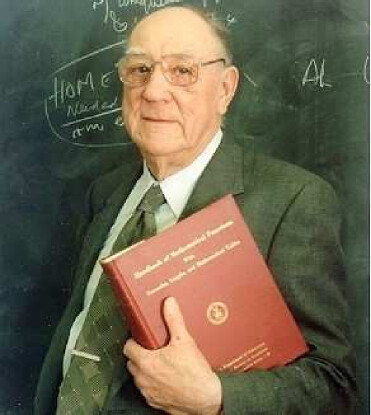Profile
Frank W. J. Olver

Frank W. J. Olver (b. 1924 in Croydon, U.K., d. 2013) received B.Sc., M.Sc., and D.Sc. degrees in mathematics from the University of London in 1945, 1948, and 1961, respectively. In 1945–1961 he was a founding member of the Mathematics Division and Head of the Numerical Methods Section at the National Physical Laboratory, Teddington, U.K.
Olver joined NIST in 1961 after having been recruited by Milton Abramowitz to be the author of the Chapter “Bessel Functions of Integer Order” in the Handbook of Mathematical Functions with Formulas, Graphs, and Mathematical Tables, a publication which went on to become the most widely distributed and most highly cited publication in NIST’s history.
Olver was an applied mathematician of world renown, one of the most widely recognized contemporary scholars in the field of special functions. He is particularly known for his extensive work in the study of the asymptotic solution of differential equations, i.e., the behavior of solutions as the independent variable, or some parameter, tends to infinity, and in the study of the particular solutions of differential equations known as special functions (e.g., Bessel functions, hypergeometric functions, Legendre functions). Having witnessed the birth of the computer age firsthand (as a colleague of Alan Turing at NPL, for example), Olver is also well known for his contributions to the development and analysis of numerical methods for computing special functions.
A highly regarded expositor, Olver was author of more than 100 technical articles. His well-known book, Asymptotics and Special Functions, was reprinted in the AKP Classics Series by AK Peters, Wellesley, Massachusetts, in 1997. He also served on the Editorial Boards of several of the leading journals devoted to mathematical and/or numerical analysis, including founding Managing Editor of the SIAM Journal on Mathematical Analysis.
In 2000, a 1,074-page commemorative volume Selected Papers of F.W.J. Olver, Parts I and II (R. Wong, ed.) was published by World Scientific Publishing Co. In a review of that volume, Jet Wimp of Drexel University said that the papers “exemplify a redoubtable mathematical talent, the work of a man who has done more than almost anyone else in the 20th century to bestow on the discipline of applied mathematics the elegance and rigor that its earliest practitioners, such as Gauss and Laplace, would have wished for it.”
After leaving NIST in 1986, Olver became a professor at the Institute for Physical Science and Technology and the Department of Mathematics at the University of Maryland. In 1992 he retired, and was appointed Professor Emeritus.
Olver was elected a Fellow of the U.K. Institute of Mathematics and its Applications in 1974, and a Foreign Member of the Royal Society of Sciences, Uppsala, Sweden in 1996. He also spent time as a Visiting Fellow, or Professor, at the University of Lancaster, U.K., University College London, U.K., Cambridge University, U.K., the Royal Irish Academy, and the National University of Australia.
In 1989 the conference “Asymptotic and Computational Analysis” was held in Winnipeg, Canada, in honor of Olver’s 65th birthday, with Proceedings published by Marcel Dekker in 1990. In April 2011, NIST co-organized a conference on “Special Functions in the 21st Century: Theory & Application” which was dedicated to Olver. Later that year Olver was honored with the U.S. Department of Commerce Gold Medal, the highest honorary award granted by the Department, and was inducted into the NIST Portrait Gallery of Distinguished Scientists, Engineers, and Administrators.
Olver continued to maintain a connection to NIST after moving to the university. Most notably, he served as the Editor-in-Chief and Mathematics Editor of the online NIST Digital Library of Mathematical Functions and its 966-page print companion, the NIST Handbook of Mathematical Functions (Cambridge University Press, 2010). Fitting capstones to Olver’s long career, these works are on track to extend the legacy of the classic Abramowitz and Stegun handbook well into the 21st century. According to DLMF Project Lead Daniel Lozier, “Olver’s encyclopedic knowledge of the field, his clear vision for mathematical exposition, his keen sense of the needs of practitioners, and his unfailing attention to detail were key to the success of that project.” Olver is the author or coauthor of the following Chapters
and editor of the mathematics (and exposition) of all of them. He continued his editing work until the time of his death on April 22, 2013 at age 88.
